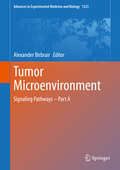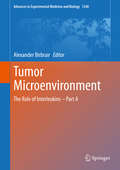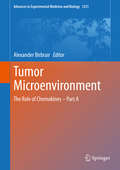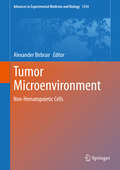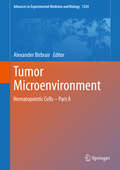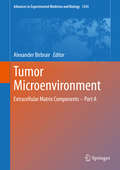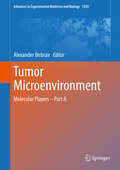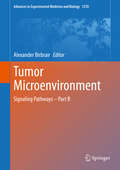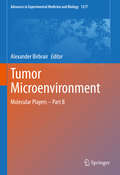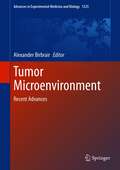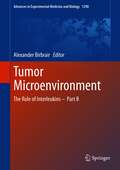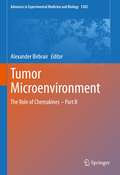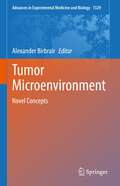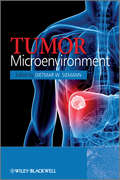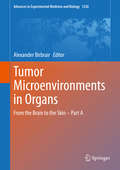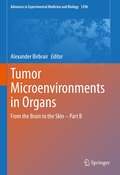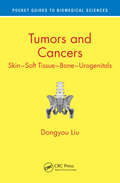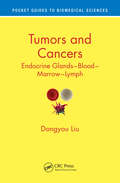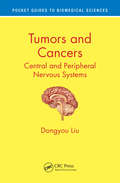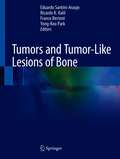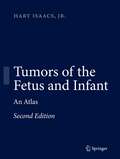- Table View
- List View
Tumor Microenvironment: Signaling Pathways – Part A (Advances in Experimental Medicine and Biology #1223)
by Alexander BirbrairRevealing essential roles of the tumor microenvironment in cancer progression, this book provides a comprehensive overview of the latest research on how different signaling pathways are important in the tumor microenvironment. Multiple signaling pathways are covered, including S1P, neuregulin, Notch, erythropoietin, Rho-ROCK, mTOR, and more.Taken alongside its companion volumes, these books update us on what we know about various aspects of the tumor microenvironment as well as future directions. Tumor Microenvironment: Signaling Pathways – Part A is essential reading for advanced cell biology and cancer biology students as well as researchers seeking an update on research in the tumor microenvironment.
Tumor Microenvironment: The Role of Interleukins – Part A (Advances in Experimental Medicine and Biology #1240)
by Alexander BirbrairRevealing essential roles of the tumor microenvironment in cancer progression, this book provides a comprehensive overview of the latest research on the role of interleukins in the tumor microenvironment. Each chapter focuses on the various ways to target the tumor microenvironment by intervention in the interleukin biology, including IL-1, IL-8, IL-21, IL-36 signaling, and more. Taken alongside its companion volumes, Tumor Microenvironment: The Role of Interleukins – Part A updates us on what we know about various aspects of the tumor microenvironment, as well as future directions. This book is essential reading for advanced cell biology and cancer biology students as well as researchers seeking an update on research in the tumor microenvironment.
Tumor Microenvironment: The Role of Chemokines – Part A (Advances in Experimental Medicine and Biology #1231)
by Alexander BirbrairRevealing essential roles of the tumor microenvironment in cancer progression, this book provides a comprehensive overview of the latest research on the role of chemokines in the tumor microenvironment. Each chapter focuses on the chemokines patterns of expression, their regulation, and their roles in immune cell recruitment, as well as how they affect cancer immunity and tumorigenesis. Taken alongside its companion volumes, Tumor Microenvironment: The Role of Chemokines – Part A updates us on what we know about various aspects of the tumor microenvironment as well as future directions. This book is essential reading for advanced cell biology and cancer biology students as well as researchers seeking a comprehensive update on research in the tumor microenvironment.
Tumor Microenvironment: Non-Hematopoietic Cells (Advances in Experimental Medicine and Biology #1234)
by Alexander BirbrairRevealing essential roles of the tumor microenvironment in cancer progression, this volume focuses on non-hematopoietic cells within the tumor microenvironment.Further, it teaches readers about the roles of distinct constituents of the tumor microenvironment and how they affect cancer development. Topics include fibroblasts, adipocytes, mesenchymal stem cells, stellate cells, and more. Taken alongside its companion volumes, Tumor Microenvironment: Non-Hematopoietic Cells updates us on what we know about the different aspects of the tumor microenvironment as well as future directions. Useful for introducing the newer generation of researchers to the history of how scientists focused in the tumor microenvironment and how this knowledge is currently applied for cancer treatments, it will be essential reading for advanced cell biology and cancer biology students as well as researchers seeking an update on research in the tumor microenvironment.All of the chapter authors are renowned international experts in the cancer biology field in specific subfields that will be the focus of their chapters.
Tumor Microenvironment: Hematopoietic Cells – Part A (Advances in Experimental Medicine and Biology #1224)
by Alexander BirbrairRevealing essential roles of the tumor microenvironment in cancer progression, this book focuses on the role of hematopoietic components of the tumor microenvironment. Further, it teaches readers about the roles of distinct constituents of the tumor microenvironment and how they affect cancer development. Topics include neutrophils, basophils, T helper cells, cytotoxic lymphocytes, fibrocytes, and myeloid-derived suppressor cells, and more.Taken alongside its companion volumes, these books update us on what we know about various aspects of the tumor microenvironment as well as future directions. Tumor Microenvironment: Hematopoietic Cells – Part A is essential reading for advanced cell biology and cancer biology students as well as researchers seeking an update on research in the tumor microenvironment.
Tumor Microenvironment: Extracellular Matrix Components – Part A (Advances in Experimental Medicine and Biology #1245)
by Alexander BirbrairRevealing essential roles of the tumor microenvironment in cancer progression, this volume focuses on the extracellular matrix components of the tumor during cancer development. Further, it teaches readers about the roles of distinct constituents of the tumor microenvironment and how they affect cancer development. Topics include heparan sulphate, hyaluronan, fibronectin, perlecan, glypican, matrix metalloproteinases, and much more. Taken alongside its companion volumes, Tumor Microenvironment: Extracellular Matrix Components – Part A updates us on what we know about the different aspects of the tumor microenvironment, as well as apprises us on the future advances in the field. For the newest generation of researchers, this volume serves as a useful introduction to the history of scientists’ focus on the tumor microenvironment, and explores how this knowledge is currently applied in cancer treatments. The book is an essential text for advanced cell biology and cancer biology students, as well as for scientists seeking an update on the developments in tumor microenvironment research.All of the chapter authors are renowned international experts in the field of cancer biology, and in the specific subfields that are the focus of their chapters.
Tumor Microenvironment: Molecular Players – Part A (Advances in Experimental Medicine and Biology #1259)
by Alexander BirbrairThis book provides a comprehensive overview of the latest research on the molecular players in the tumor microenvironment, including Cathepsin D, galectins, iron, oxygen, Phospholipase D1, leptin, extracellular vesicles, and more. Taken alongside its companion volumes, these books update us on what we know about the tumor microenvironment as well as future directions. Tumor Microenvironment: Molecular Players – Part A is essential reading for advanced cell biology and cancer biology students as well as researchers seeking an update on research in the tumor microenvironment.
Tumor Microenvironment: Signaling Pathways – Part B (Advances in Experimental Medicine and Biology #1270)
by Alexander BirbrairRevealing essential roles of the tumor microenvironment in cancer progression, this book provides a comprehensive overview of the latest research on how different signaling pathways are important in the tumor microenvironment. Multiple signaling pathways are covered, including Src, Neuregulin, Adenosine, TGFβ, Androgen, Wnt, and more.Taken alongside its companion volumes, these books update us on what we know about various aspects of the tumor microenvironment as well as future directions. Tumor Microenvironment: Signaling Pathways – Part B is essential reading for advanced cell biology and cancer biology students as well as researchers seeking an update on research in the tumor microenvironment.
Tumor Microenvironment: Molecular Players – Part B (Advances in Experimental Medicine and Biology #1277)
by Alexander BirbrairThis book provides a comprehensive overview of the latest research on the molecular players in the tumor microenvironment, including MicroRNAs, estrogen, Caveolin-1, Nitric Oxide, RANK/RANKL signaling, , COX-2 Signaling, Renin–angiotensin system, and more. Taken alongside its companion volumes, Tumor Microenvironment: Molecular Players – Part B updates us on what we know about the tumor microenvironment, as well as future directions. This book is essential reading for advanced cell biology and cancer biology students as well as researchers seeking an update on research in the tumor microenvironment.
Tumor Microenvironment: Hematopoietic Cells – Part B (Advances in Experimental Medicine and Biology #1273)
by Alexander BirbrairRevealing essential roles of the tumor microenvironment in cancer progression, this book focuses on the role of hematopoietic components of the tumor microenvironment. Further, it teaches readers about the roles of distinct constituents of the tumor microenvironment and how they affect cancer development. Topics include eosinophils, NK cells, γδ T cells, regulatory T Cells, Langerhans cells, hematopoietic stem cells, Mast cells, B cells and Microglia, and more. Taken alongside its companion volumes, Tumor Microenvironment: Hematopoietic Cells – Part B updates us on what we know about various aspects of the tumor microenvironment as well as future directions. This book is essential reading for advanced cell biology and cancer biology students as well as researchers seeking an update on research in the tumor microenvironment.
Tumor Microenvironment: Recent Advances (Advances in Experimental Medicine and Biology #1225)
by Alexander BirbrairThis volume discusses recent research advances in cancer biology, focusing on the role of the tumor microenvironment. Taken alongside its companion volumes, Tumor Microenvironment: Recent Advances covers the latest research on various aspects of the tumor microenvironment, as well as future directions. Useful for introducing the newer generation of researchers to the history of how scientists studied the tumor microenvironment as well as how this knowledge is currently applied for cancer treatments, it will be essential reading for advanced cell biology and cancer biology students, as well as researchers seeking an update on research on the tumor microenvironment.
Tumor Microenvironment: The Role of Interleukins – Part B (Advances in Experimental Medicine and Biology #1290)
by Alexander BirbrairRevealing essential roles of the tumor microenvironment in cancer progression, this book provides a comprehensive overview of the latest research on the role of interleukins in the tumor microenvironment. Each chapter focuses on the various ways to target the tumor microenvironment by intervention in the interleukin biology, including IL-6, IL-7, IL-10, IL-12, IL-22, IL-23, and IL-24 signaling.Taken alongside its companion volumes, Tumor Microenvironment: The Role of Interleukins – Part B updates us on what we know about various aspects of the tumor microenvironment, as well as future directions. This book is essential reading for advanced cell biology and cancer biology students as well as researchers seeking an update on research in the tumor microenvironment.
Tumor Microenvironment: The Role of Chemokines – Part B (Advances in Experimental Medicine and Biology #1302)
by Alexander BirbrairRevealing essential roles of the tumor microenvironment in cancer progression, this book provides a comprehensive overview of the latest research on the role of chemokines in the tumor microenvironment. Each chapter focuses on the chemokines patterns of expression, their regulation, and their roles in immune cell recruitment, as well as how they affect cancer immunity and tumorigenesis.Taken alongside its companion volumes, Tumor Microenvironment: The Role of Chemokines – Part B updates us on what we know about various aspects of the tumor microenvironment, as well as apprises us on future directions in the field. This book is essential reading for advanced cell biology and cancer biology students as well as scientists seeking an update on recent developments and research in the tumor microenvironment.
Tumor Microenvironment: Novel Concepts (Advances in Experimental Medicine and Biology #1329)
by Alexander BirbrairThis volume discusses novel concepts in cancer biology, focusing on different factors that affect the tumor microenvironment. Topics covered include sex-based differences in the tumor microenironment, dormancy in the tumor microenvironment, the influence of obesity on the tumor microenvironment, and much more. Taken alongside its companion volumes, Tumor Microenvironment: Novel Concepts covers the latest research on various aspects of the tumor microenvironment, as well as future directions. Useful for introducing the newer generation of researchers to the history of how scientists studied the tumor microenvironment as well as how this knowledge is currently applied for cancer treatments, it will be essential reading for advanced cell biology and cancer biology students, as well as researchers seeking an update on research on the tumor microenvironment.
Tumor Microenvironment: The Main Driver of Metabolic Adaptation (Advances in Experimental Medicine and Biology #1219)
by Jacinta SerpaThe way a cell undergoes malignant transformation should meet their capacity of surviving in the microenvironment of the organ where the cancer will develop. Metabolic adaptation is for sure one of the criteria that must be accomplished, driven by metabolic plasticity that allows the adaptation of cancer cells to the availability of energy and biomass sources that will sustain cell survival and proliferation. Each human organ has a particular microenvironment which depends on several cell types and in some cases also on symbiotic microorganisms. These biological partners are constantly sharing organic compounds and signaling molecules that will control mitogenesis, cell death and differentiation, accounting for the organ's function. Nevertheless, cancer cells are capable of taking advantage of this metabolic and signaling microenvironmental dynamics.In this book, we intend to present the different components of the microenvironment driving the metabolic fitness of cancer cells. The metabolic changes required for establishing a tumor in a given microenvironment and how these metabolic changes limit the response to drugs will generally be the major items addressed. It is important to mention not only aspects of the microenvironment that stimulate metabolic changes and that select better adapted tumor cells, but also how this regulation of cell plasticity is made. Thus, the signaling pathways that orchestrate and are orchestrated throughout this panoply of metabolic rearrangements will also be addressed in this book. The subjects will be presented from the conceptual point of view of the cross-cancer mechanisms and also particularizing some models that can be examples and enlightening within the different areas.
Tumor Microenvironment
by Dietmar W. SiemannThe microenvironment in which a tumor originates plays a critical role in its initiation and progression. Tumor Microenvironment reviews the importance of tumor microenvironment in cancer management. Particular emphasis is placed on discussing how the unique characteristics of the tumor microenvironment not only impact disease progression and response to conventional anticancer therapies, but have also led to the identification of potential new therapeutic targets and treatment possibilities for cancer patients. Tumor Microenvironment also reviews the fundamental basis of target development, preclinical assessment, and the current clinical status of these therapies.
Tumor Microenvironments in Organs: From the Brain to the Skin – Part A (Advances in Experimental Medicine and Biology #1226)
by Alexander BirbrairRevealing essential roles of the tumor microenvironment in cancer progression, this book provides a comprehensive overview of the latest research on the tumor microenvironment in over thirty human organs, including the parathyroid gland, heart, intestine, testicles, and more.Taken alongside its companion volumes, these books update us on what we know about the different aspects of the tumor microenvironments in distinct organs as well as future directions. Tumor Microenvironments in Organs: From the Brain to the Skin – Part A is essential reading for advanced cell biology and cancer biology students as well as researchers seeking an update on research in the tumor microenvironment.
Tumor Microenvironments in Organs: From the Brain to the Skin – Part B (Advances in Experimental Medicine and Biology #1296)
by Alexander BirbrairRevealing essential roles of the tumor microenvironment components in cancer progression, this book provides a comprehensive overview of the latest research on the tumor microenvironment in several organs, including brain, neck, tongue, larynges, esophagus, carotid body, breast, prostate, ovary, endometrium, liver, pancreas, bladder, penis, seminal vesicle, retina, and pituitary, pineal and sweat glands, and more.Taken alongside its companion volumes, Tumor Microenvironments in Organs: From the Brain to the Skin – Part B updates us on what we know about the different aspects of the tumor microenvironments in distinct organs as well as future directions. This book is essential reading for advanced cell biology and cancer biology students as well as researchers seeking an update on research in the tumor microenvironment.
Tumor Profiling: Methods And Protocols (Methods In Molecular Biology Series #1908)
by Sarah S. MurrayThis book provides a practical guide to current methods for profiling and interpreting genomic alterations in tumors. Chapters detail methods to interrogate DNA variation, RNA expression, and epigenetic changes using both next-generation sequencing and microarray techniques, common bioinformatics and annotation tools to glean relevant driver genomic events, and different performance characteristics as well as quality metrics necessary for the robust validation of tumor profiling as a diagnostic test for medical laboratories. Written in the highly successful Methods in Molecular Biology series format, chapters include introductions to their respective topics, lists of the necessary materials and reagents, step-by-step, readily reproducible laboratory protocols, and tips on troubleshooting and avoiding known pitfalls. Authoritative and cutting-edge, Tumor Profiling: Methods and Protocols aims to be a useful resource for learning about technical details, applications, and strengths and limitations of the latest technologies as applied to this increasingly important field.
Tumors and Cancers: Skin – Soft Tissue – Bone – Urogenitals (Pocket Guides to Biomedical Sciences)
by Dongyou LiuTumors and Cancers: Skin – Soft Tissue – Bone – Urogenitals provides succinct reviews of neoplastic growths disrupting normal functions of affected structures. Each chapter presents a state of the art summary of tumor/cancer of a particular type in relation to its biology, epidemiology, disease mechanisms, clinical signs, diagnosis, treatment and prognosis.
Tumors and Cancers: Endocrine Glands – Blood – Marrow – Lymph (Pocket Guides to Biomedical Sciences)
by Dongyou LiuTumors and Cancers: Endocrine Glands – Blood – Marrow – Lymph provides succinct reviews of neoplastic growths disrupting normal functions of affected structures. Each chapter presents a state of the art summary of tumor/cancer of a particular type in relation to its biology, epidemiology, disease mechanisms, clinical signs, diagnosis, treatment and prognosis.
Tumors and Cancers: Central and Peripheral Nervous Systems (Pocket Guides to Biomedical Sciences)
by Dongyou LiuTumors and cancers are insidious diseases characterized by an abnormal growth of cells that extend beyond their usual boundaries and disrupt the normal functions of affected organs. Forming the first of the four volumes devoted to tumors and cancers, this volume focuses on the central and peripheral nervous systems. Each chapter presents a state of the art summary of tumor/cancer of a particular type in relation to its definition, biology, epidemiology, disease mechanism/pathogenesis, clinical signs, diagnosis, treatment and prognosis.
Tumors and Cancers: Head – Neck – Heart – Lung – Gut (Pocket Guides to Biomedical Sciences)
by Dongyou LiuTumors and cancers are insidious diseases characterized by uncontrolled growth of abnormal cells that extend beyond their usual boundaries and disrupt the normal functions of affected organs. Forming the second of the four volumes devoted to tumors and cancers, this volume focuses on the head/neck, cardiovascular, respiratory and digestive systems. Each chapter presents a state of the art summary of tumor/cancer of a particular organ/type in relation to its definition, biology, epidemiology, disease mechanism/pathogenesis, clinical signs, diagnosis, treatment and prognosis.
Tumors and Tumor-Like Lesions of Bone: For Surgical Pathologists, Orthopedic Surgeons And Radiologists
by Eduardo Santini-Araujo Ricardo K. Kalil Franco Bertoni Yong-Koo ParkThis updated second edition of a successful book provides essential, internationally applicable information in the area of bone and joint pathology with emphasis on practical diagnostic aspects, including many illustrations: roentgenograms, CT-scans, MRI, scintigraphies, as well as pictures of gross surgical specimens and microphotographs, immunohistochemical reactions and genomics. Information on histopathological and molecular diagnosis, and basic therapeutic guidelines are provided. This book offers generous coverage of epidemiology, clinical features, radiology, pathology, differential diagnosis, prognosis and treatment, not only for common lesions, but also for those less frequently encountered, including lesions of joints. The content is arranged based on the World Health Organization’s Consensus Classification, with the addition of other lesions not included therein. Tumors and Tumor-Like Lesions of Bone provides day-to-day assistance to general and specialized surgical pathologists, radiologists, orthopedic, head and neck and dental surgeons, oncologists and rheumatologists.
Tumors of the Fetus and Infant
by Hart IsaacsOver the past two decades, the remarkable advances in imaging techniques, such as ultrasound and fast or ultra-fast MRI, have led to the diagnosis of an increasing number of tumors at the prenatal stage. This revised, abundantly illustrated second edition of Tumors of the Fetus and Infant: An Atlas presents an up-to-date account of the clinical and pathological features of neoplastic disease and tumor-like conditions in the fetus, neonate, and infant and discusses major tumor studies and cases from throughout the world. The full range of tumors is covered, with each chapter reviewing the incidence, clinical findings, cytogenetics, pathology, radiology, treatment, and prognosis. The goal is to enable pathologists and clinicians to gain a clear understanding of these lesions so that a correct diagnosis can be achieved and appropriate treatment, initiated.
